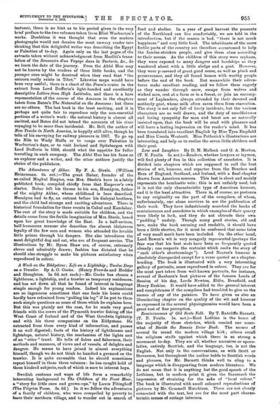Swedish customs and ways of life form a remarkably interesting
background to The Children of the Frost Moor, a "story for little ones and grown-ups," by Laura Fitinghoff (The Pilgrim Press. 3s. 6d.). In it we follow the adventures of a family of children, who were compelled by poverty to leave their northern village, and to wander out in search of
food and shelter. In a year of good harvest the peasants of the Northland can live comfortably, we are told in the introduction, but if the season is bad, "there is not much happiness" and very little food. The inhabitants of the more fertile parts of the country are therefore accustomed to help the famine-stricken people, and give them alms according to their means. As the children of this story were orphans, they were exposed to many dangers and hardships as they wandered about with a little sledge and a goat. However, they were possessed of great good sense, as well as pluck and perseverance, and they all found homes with worthy people before the end of the book. But meanwhile their adven- tures make excellent reading, and we follow them eagerly as they wander through snow, escape from wolves and wicked men, rest at a farm or in a forest., or join an encamp- ment of Laplanders, always attended by their devoted and motherly goat, whose milk often saves them from starvation. The story is not only full of lively incidents, but the various characters are so well drawn, and the duty of unselfishness and loving sympathy for man and beast are so naturally insisted upon, that the book will be read with pleasure and will leave a lasting impression on the reader's mind. It has been translated into excellent English by Miss Tyra, Engdahl and Miss Ursula Wcstcott. Miss Petherick's illustrations are interesting, and help us to realize the seven little children and their goat.


































































 Previous page
Previous page